Thomas Ferreira de Lima
A system-on-chip microwave photonic processor solves dynamic RF interference in real time with picosecond latency
Jun 26, 2023Abstract:Radio-frequency interference is a growing concern as wireless technology advances, with potentially life-threatening consequences like interference between radar altimeters and 5G cellular networks. Mobile transceivers mix signals with varying ratios over time, posing challenges for conventional digital signal processing (DSP) due to its high latency. These challenges will worsen as future wireless technologies adopt higher carrier frequencies and data rates. However, conventional DSPs, already on the brink of their clock frequency limit, are expected to offer only marginal speed advancements. This paper introduces a photonic processor to address dynamic interference through blind source separation (BSS). Our system-on-chip processor employs a fully integrated photonic signal pathway in the analogue domain, enabling rapid demixing of received mixtures and recovering the signal-of-interest in under 15 picoseconds. This reduction in latency surpasses electronic counterparts by more than three orders of magnitude. To complement the photonic processor, electronic peripherals based on field-programmable gate array (FPGA) assess the effectiveness of demixing and continuously update demixing weights at a rate of up to 305 Hz. This compact setup features precise dithering weight control, impedance-controlled circuit board and optical fibre packaging, suitable for handheld and mobile scenarios. We experimentally demonstrate the processor's ability to suppress transmission errors and maintain signal-to-noise ratios in two scenarios, radar altimeters and mobile communications. This work pioneers the real-time adaptability of integrated silicon photonics, enabling online learning and weight adjustments, and showcasing practical operational applications for photonic processing.
Real-Time Blind Photonic Interference Cancellation for mmWave MIMO
May 06, 2023Abstract:Multiple-input multiple-output (MIMO) mmWave devices broadcast multiple spatially-separated data streams simultaneously in order to increase data transfer rates. Data transfer can, however, be compromised by interference. Conventional techniques for mitigating interference require additional space and power not generally available in handheld mobile devices. Here, we propose a photonic mmWave MIMO receiver architecture capable of interference cancellation with greatly reduced space and power needs. We demonstrate real-time photonic interference cancellation with an integrated FPGA-photonic system that executes a novel zero-calibration micro-ring resonator control algorithm. The system achieves sub-second cancellation weight determination latency with sub-Nyquist sampling. We evaluate the impact of canceller design parameters on performance, establishing that effective photonic cancellation is possible in handheld devices with less than 30 ms weight determination latency.
Wideband physical layer cognitive radio with an integrated photonic processor for blind source separation
May 17, 2022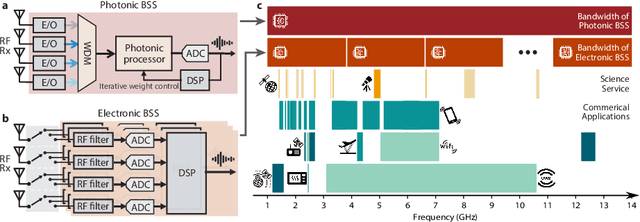
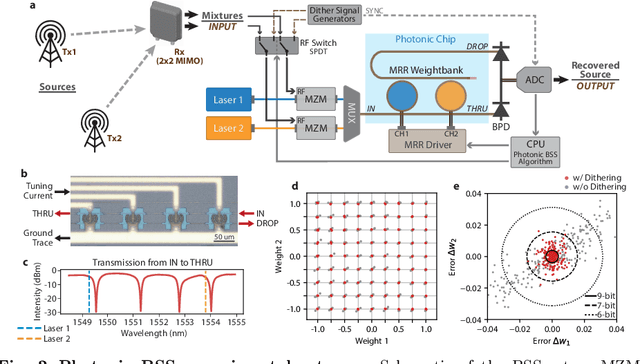
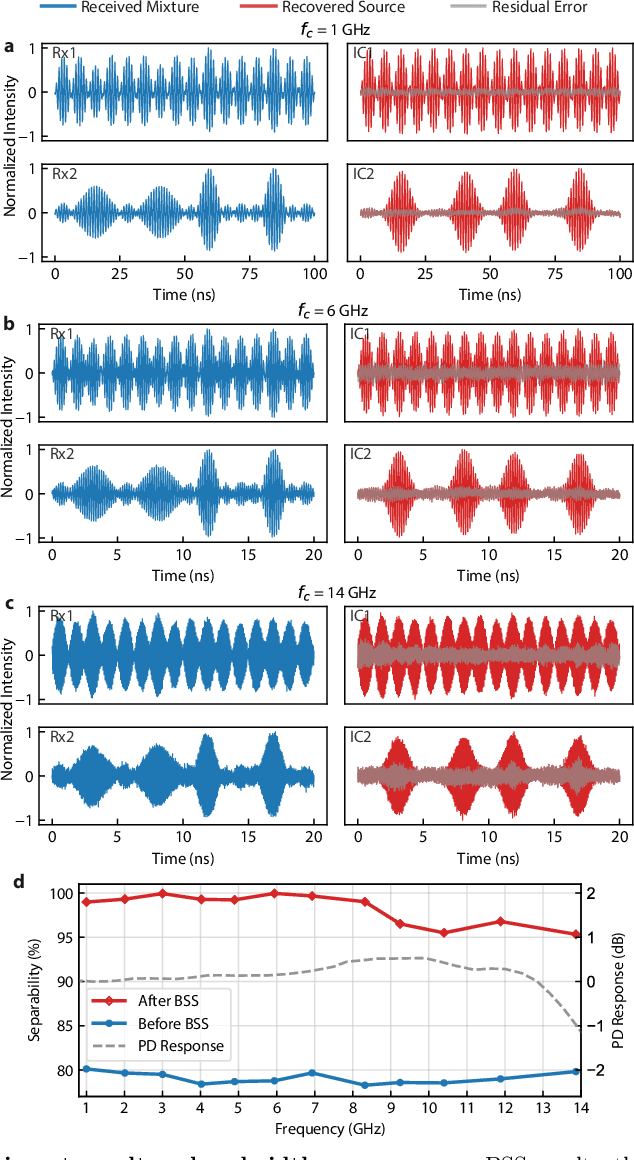
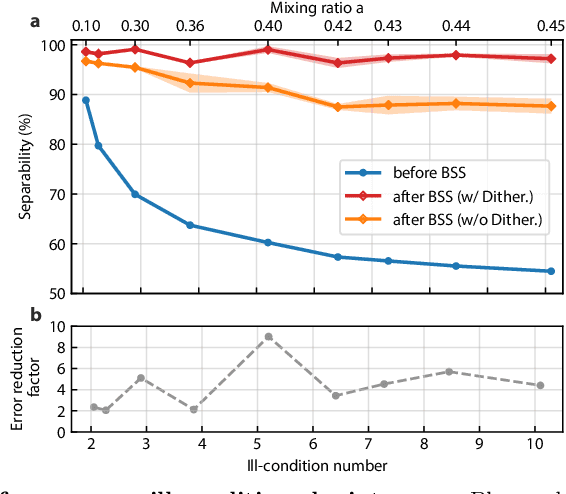
Abstract:The expansion of telecommunications incurs increasingly severe crosstalk and interference, and a physical layer cognitive method, called blind source separation (BSS), can effectively address these issues. BSS requires minimal prior knowledge to recover signals from their mixtures, agnostic to carrier frequency, signal format, and channel conditions. However, the previous BSS implemented in electronics did not fulfill this versatility due to the inherently narrow bandwidth of radio-frequency (RF) components, the high energy consumption of digital signal processors (DSP), and their shared weaknesses of low scalability. Here, we report a photonic BSS approach that inherits the advantages of optical devices and can fully fulfill its "blindness" aspect. Using a microring weight bank integrated on a photonic chip, we demonstrate energy-efficient, WDM-scalable BSS across 13.8 GHz of bandwidth, covering many standard frequency bands. Our system also has high (9-bit) accuracy for signal demixing thanks to a recently developed dithering control method, resulting in higher signal of interest ratios (SIR) even for ill-conditioned mixtures.
Silicon photonic-electronic neural network for fibre nonlinearity compensation
Oct 11, 2021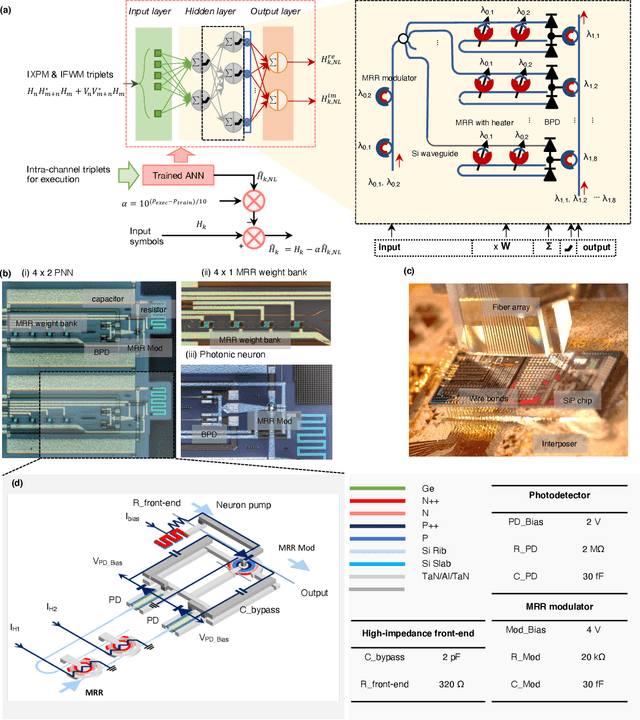
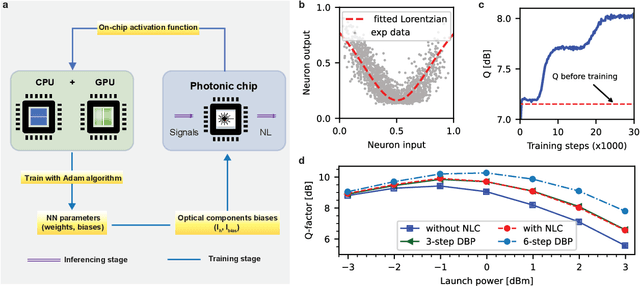
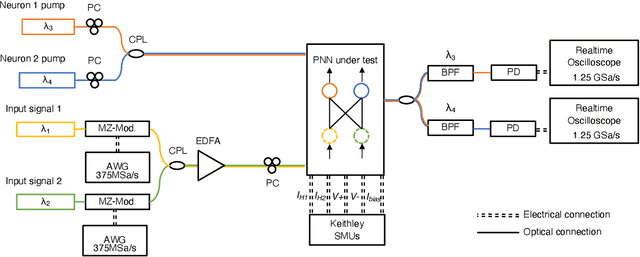
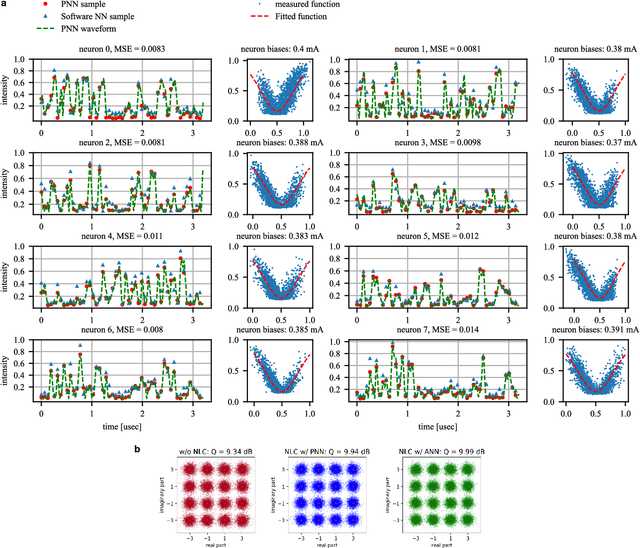
Abstract:In optical communication systems, fibre nonlinearity is the major obstacle in increasing the transmission capacity. Typically, digital signal processing techniques and hardware are used to deal with optical communication signals, but increasing speed and computational complexity create challenges for such approaches. Highly parallel, ultrafast neural networks using photonic devices have the potential to ease the requirements placed on the digital signal processing circuits by processing the optical signals in the analogue domain. Here we report a silicon photonice-lectronic neural network for solving fibre nonlinearity compensation of submarine optical fibre transmission systems. Our approach uses a photonic neural network based on wavelength-division multiplexing built on a CMOS-compatible silicon photonic platform. We show that the platform can be used to compensate optical fibre nonlinearities and improve the signal quality (Q)-factor in a 10,080 km submarine fibre communication system. The Q-factor improvement is comparable to that of a software-based neural network implemented on a 32-bit graphic processing unit-assisted workstation. Our reconfigurable photonic-electronic integrated neural network promises to address pressing challenges in high-speed intelligent signal processing.
A Photonic-Circuits-Inspired Compact Network: Toward Real-Time Wireless Signal Classification at the Edge
Jun 25, 2021



Abstract:Machine learning (ML) methods are ubiquitous in wireless communication systems and have proven powerful for applications including radio-frequency (RF) fingerprinting, automatic modulation classification, and cognitive radio. However, the large size of ML models can make them difficult to implement on edge devices for latency-sensitive downstream tasks. In wireless communication systems, ML data processing at a sub-millisecond scale will enable real-time network monitoring to improve security and prevent infiltration. In addition, compact and integratable hardware platforms which can implement ML models at the chip scale will find much broader application to wireless communication networks. Toward real-time wireless signal classification at the edge, we propose a novel compact deep network that consists of a photonic-hardware-inspired recurrent neural network model in combination with a simplified convolutional classifier, and we demonstrate its application to the identification of RF emitters by their random transmissions. With the proposed model, we achieve 96.32% classification accuracy over a set of 30 identical ZigBee devices when using 50 times fewer training parameters than an existing state-of-the-art CNN classifier. Thanks to the large reduction in network size, we demonstrate real-time RF fingerprinting with 0.219 ms latency using a small-scale FPGA board, the PYNQ-Z1.
Photonics for artificial intelligence and neuromorphic computing
Nov 12, 2020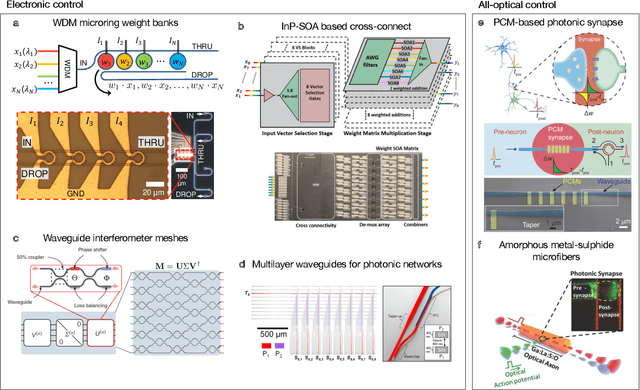
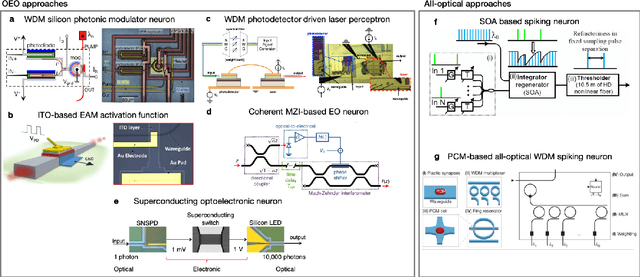
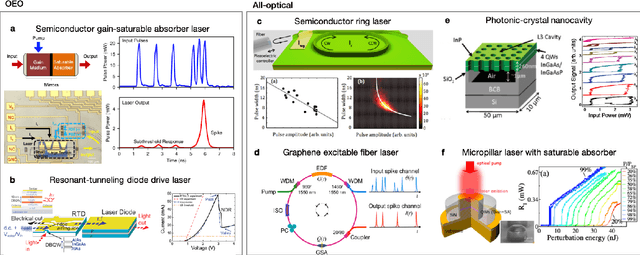
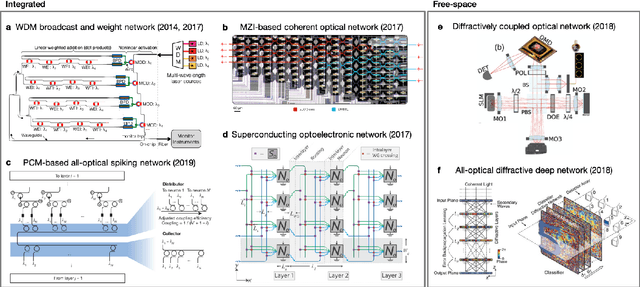
Abstract:Research in photonic computing has flourished due to the proliferation of optoelectronic components on photonic integration platforms. Photonic integrated circuits have enabled ultrafast artificial neural networks, providing a framework for a new class of information processing machines. Algorithms running on such hardware have the potential to address the growing demand for machine learning and artificial intelligence, in areas such as medical diagnosis, telecommunications, and high-performance and scientific computing. In parallel, the development of neuromorphic electronics has highlighted challenges in that domain, in particular, related to processor latency. Neuromorphic photonics offers sub-nanosecond latencies, providing a complementary opportunity to extend the domain of artificial intelligence. Here, we review recent advances in integrated photonic neuromorphic systems, discuss current and future challenges, and outline the advances in science and technology needed to meet those challenges.
Noise Analysis of Photonic Modulator Neurons
Jul 17, 2019
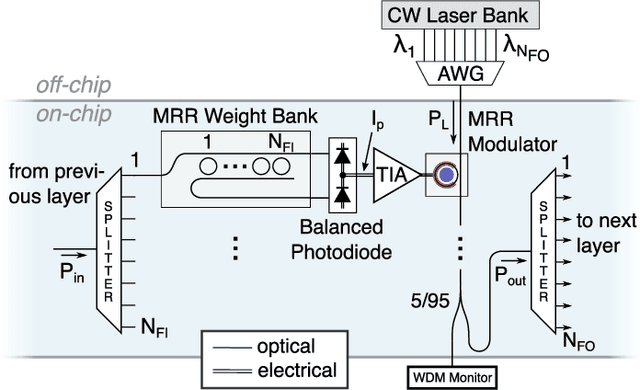
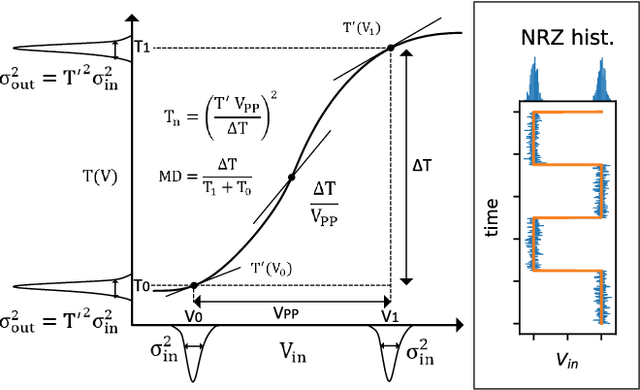
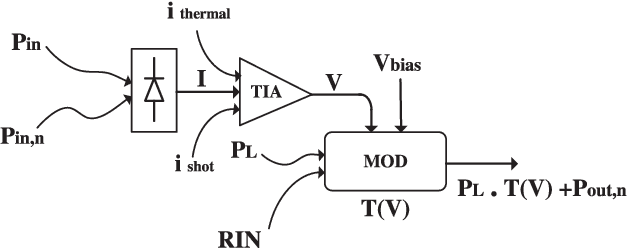
Abstract:Neuromorphic photonics relies on efficiently emulating analog neural networks at high speeds. Prior work showed that transducing signals from the optical to the electrical domain and back with transimpedance gain was an efficient approach to implementing analog photonic neurons and scalable networks. Here, we examine modulator-based photonic neuron circuits with passive and active transimpedance gains, with special attention to the sources of noise propagation. We find that a modulator nonlinear transfer function can suppress noise, which is necessary to avoid noise propagation in hardware neural networks. In addition, while efficient modulators can reduce power for an individual neuron, signal-to-noise ratios must be traded off with power consumption at a system level. Active transimpedance amplifiers may help relax this tradeoff for conventional p-n junction silicon photonic modulators, but a passive transimpedance circuit is sufficient when very efficient modulators (i.e. low C and low V-pi) are employed.
Neuromorphic Silicon Photonic Networks
Jun 12, 2017



Abstract:Photonic systems for high-performance information processing have attracted renewed interest. Neuromorphic silicon photonics has the potential to integrate processing functions that vastly exceed the capabilities of electronics. We report first observations of a recurrent silicon photonic neural network, in which connections are configured by microring weight banks. A mathematical isomorphism between the silicon photonic circuit and a continuous neural network model is demonstrated through dynamical bifurcation analysis. Exploiting this isomorphism, a simulated 24-node silicon photonic neural network is programmed using "neural compiler" to solve a differential system emulation task. A 294-fold acceleration against a conventional benchmark is predicted. We also propose and derive power consumption analysis for modulator-class neurons that, as opposed to laser-class neurons, are compatible with silicon photonic platforms. At increased scale, Neuromorphic silicon photonics could access new regimes of ultrafast information processing for radio, control, and scientific computing.
* 12 pages, 4 figures, accepted in Scientific Reports
 Add to Chrome
Add to Chrome Add to Firefox
Add to Firefox Add to Edge
Add to Edge